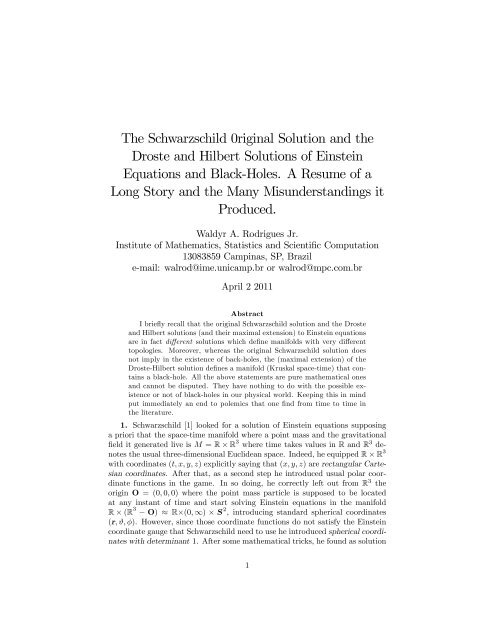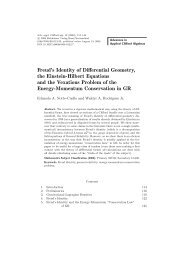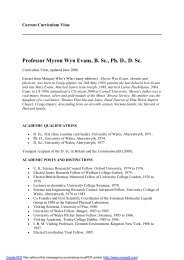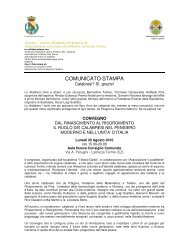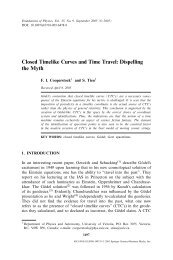The Schwarzschild 0riginal Solution and the Droste and Hilbert ...
The Schwarzschild 0riginal Solution and the Droste and Hilbert ...
The Schwarzschild 0riginal Solution and the Droste and Hilbert ...
Create successful ePaper yourself
Turn your PDF publications into a flip-book with our unique Google optimized e-Paper software.
<strong>The</strong> <strong>Schwarzschild</strong> <strong>0riginal</strong> <strong>Solution</strong> <strong>and</strong> <strong>the</strong><br />
<strong>Droste</strong> <strong>and</strong> <strong>Hilbert</strong> <strong>Solution</strong>s of Einstein<br />
Equations <strong>and</strong> Black-Holes. A Resume of a<br />
Long Story <strong>and</strong> <strong>the</strong> Many Misunderst<strong>and</strong>ings it<br />
Produced.<br />
Waldyr A. Rodrigues Jr.<br />
Institute of Ma<strong>the</strong>matics, Statistics <strong>and</strong> Scientific Computation<br />
13083859 Campinas, SP, Brazil<br />
e-mail: walrod@ime.unicamp.br or walrod@mpc.com.br<br />
April 2 2011<br />
Abstract<br />
I briefly recall that <strong>the</strong> original <strong>Schwarzschild</strong> solution <strong>and</strong> <strong>the</strong> <strong>Droste</strong><br />
<strong>and</strong> <strong>Hilbert</strong> solutions (<strong>and</strong> <strong>the</strong>ir maximal extension) to Einstein equations<br />
are in fact different solutions which define manifolds with very different<br />
topologies. Moreover, whereas <strong>the</strong> original <strong>Schwarzschild</strong> solution does<br />
not imply in <strong>the</strong> existence of back-holes, <strong>the</strong> (maximal extension) of <strong>the</strong><br />
<strong>Droste</strong>-<strong>Hilbert</strong> solution defines a manifold (Kruskal space-time) that contains<br />
a black-hole. All <strong>the</strong> above statements are pure ma<strong>the</strong>matical ones<br />
<strong>and</strong> cannot be disputed. <strong>The</strong>y have nothing to do with <strong>the</strong> possible existence<br />
or not of black-holes in our physical world. Keeping this in mind<br />
put immediately an end to polemics that one find from time to time in<br />
<strong>the</strong> literature.<br />
1. <strong>Schwarzschild</strong> [1] looked for a solution of Einstein equations supposing<br />
a priori that <strong>the</strong> space-time manifold where a point mass <strong>and</strong> <strong>the</strong> gravitational<br />
field it generated live is M = R × R 3 where time takes values in R <strong>and</strong> R 3 denotes<br />
<strong>the</strong> usual three-dimensional Euclidean space. Indeed, he equipped R × R 3<br />
with coordinates (t, x, y, z) explicitly saying that (x, y, z) are rectangular Cartesian<br />
coordinates. After that, as a second step he introduced usual polar coordinate<br />
functions in <strong>the</strong> game. In so doing, he correctly left out from R 3 <strong>the</strong><br />
origin O = (0, 0, 0) where <strong>the</strong> point mass particle is supposed to be located<br />
at any instant of time <strong>and</strong> start solving Einstein equations in <strong>the</strong> manifold<br />
R × (R 3 − O) ≈ R×(0, ∞) × S 2 , introducing st<strong>and</strong>ard spherical coordinates<br />
(r, ϑ, φ). However, since those coordinate functions do not satisfy <strong>the</strong> Einstein<br />
coordinate gauge that <strong>Schwarzschild</strong> need to use he introduced spherical coordinates<br />
with determinant 1. After some ma<strong>the</strong>matical tricks, he found as solution<br />
1
of his problem a metric field g S, which has a unique singularity at O <strong>and</strong> as<br />
such his solution does not imply in any black-hole.<br />
2. However, in fact <strong>Schwarzschild</strong>, in order to determine one of <strong>the</strong> integration<br />
constants of <strong>the</strong> differential equations he was solving, needed for his<br />
calculations to use <strong>the</strong> manifold with boundary 1 R×[0, ∞) × S 2 <strong>and</strong> thus his<br />
original mass point supposed to be located for any instant of time at <strong>the</strong> point<br />
O ∈ R 3 ended to be represented by <strong>the</strong> manifold 2 {0} × S 2 (something obviously<br />
odd that <strong>Hilbert</strong> elegantly, without criticizing <strong>Schwarzschild</strong>, observed in<br />
a footnote of his paper on <strong>the</strong> <strong>Schwarzschild</strong> solution).<br />
3. Before proceeding, <strong>and</strong> in order to avoid any confusion note that despite<br />
<strong>the</strong> fact that <strong>the</strong> original manifold postulated as model of space-time by<br />
<strong>Schwarzschild</strong> is R × R 3 this does not imply that this manifold or <strong>the</strong> manifold<br />
R×[0, ∞) × S 2 equipped with <strong>the</strong> Levi-Civita connection D of g S (that solves<br />
Einstein equation) is flat. In fact, <strong>the</strong> connection D for <strong>Schwarzschild</strong> problem<br />
is curved, this statement meaning that its Riemann curvature tensor is non null.<br />
Please, take always this into account [3]:<br />
“Manifolds do not have curvature, it is <strong>the</strong> connection imposed on a manifold<br />
that may or may not have non null curvature (<strong>and</strong>/or non null torsion, non<br />
null nonmetricty). Some manifolds may be bended surfaces in a Euclidean<br />
(or pseudo-Euclidean) space of appropriate dimension. But to be bended (a<br />
property described by <strong>the</strong> so called shape tensor) has in general nothing to do<br />
with <strong>the</strong> fact that a connection defined in <strong>the</strong> manifold is curved.”<br />
4. <strong>Droste</strong> [2] <strong>and</strong> <strong>Hilbert</strong> [4] found independently ano<strong>the</strong>r solution of Einstein<br />
equations based on different assumptions than <strong>the</strong> ones used by <strong>Schwarzschild</strong><br />
3 . Modern relativists 4 (following <strong>Droste</strong> <strong>and</strong> <strong>Hilbert</strong>) find as solution 5<br />
with rotational symmetry of Einstein equations in vacuum a metric field g DH<br />
(at least C 2 ) defined in <strong>the</strong> manifold R×(0, 2m) ∪ (2m, ∞) × S 2 . Relativists say<br />
that <strong>the</strong> “part”R×(0, 2m) × S 2 where <strong>the</strong> solution is valid defines a black-hole.<br />
5. It is crucial to have in mind that <strong>the</strong> quasi spherical coordinates functions<br />
(r, ϑ, φ) used by modern relativists are such that <strong>the</strong> coordinate function r is<br />
not <strong>the</strong> <strong>Schwarzschild</strong> spherical coordinate function r , i.e.,<br />
r �= r.<br />
1 For <strong>the</strong> use of <strong>the</strong> concept of manifold with voundary to present singularities in General<br />
Relativity, see, [5, 9, 10, 8]. For some skifull commentaries on <strong>the</strong> peril of using boundary<br />
manifolds in General Relativity without taking due care see [11]<br />
2 {0} denotes <strong>the</strong> set whose unique element is 0 ∈ [0, ∞) , i.e., <strong>the</strong> boundary of <strong>the</strong> semi-line<br />
[0, ∞).<br />
3 In <strong>the</strong> words of Synge [12]: <strong>Schwarzschild</strong> imposed spherical symmetry, whereas <strong>Droste</strong><br />
<strong>and</strong> <strong>Hilbert</strong> imposed rotationalsymmetry, a subtle but crucial detail.<br />
4 See, e.g., [5, 7]<br />
5 Eventually, it would better to say, as did O’Neill in his book [7] that we start looking for<br />
one solution of a problem <strong>and</strong> ended with two solutions.<br />
2
6. <strong>Schwarzschild</strong> wrote his final formula for g S using a function R(r) which<br />
is formally identical to <strong>the</strong> <strong>Droste</strong>-<strong>Hilbert</strong> formula for g DH if R(r) is read as <strong>the</strong><br />
coordinate function r. However, <strong>Schwarzschild</strong> solution is valid only for R(r) ><br />
2m whereas <strong>the</strong> <strong>Droste</strong>-<strong>Hilbert</strong> solution is valid for any r ∈ (0, 2m) ∪ (2m, ∞).<br />
7. Of course, <strong>the</strong>re is no sense in supposing that space-time has a disconnected<br />
topology. Thus, under <strong>the</strong> present ideology of finding maximal extension<br />
of manifolds equipped with Lorentzian metrics as <strong>the</strong> true representatives of<br />
gravitational fields, relativists maximally extend <strong>the</strong> solution g DH to a solution<br />
g valid in a connected manifold called <strong>the</strong> Kruskal (sometimes, Kruskal-<br />
Szekeres) space-time [6, 13]. <strong>The</strong> total Kruskal manifold which has an exotic<br />
topology describes a hypo<strong>the</strong>tical object called <strong>the</strong> wormhole. <strong>The</strong> final solution<br />
g is presented as a function of <strong>the</strong> coordinate functions (u, v, ϑ, ϕ) <strong>and</strong> r which<br />
(keep this in mind) becomes an implicit function of <strong>the</strong> coordinate functions<br />
(u, v).<br />
8. It is assumed by relativists that a connected “part”of <strong>the</strong> Kruskal manifold<br />
describes a black-hole where g has a real singularity only at <strong>the</strong> place<br />
defined by <strong>the</strong> function r(u, v) = 0.<br />
9. In conclusion, <strong>Schwarzschild</strong> original solution <strong>and</strong> <strong>the</strong> Kruskal extension<br />
of <strong>the</strong> <strong>Droste</strong>-<strong>Hilbert</strong> solution define space-times with very different topologies,<br />
so <strong>the</strong>y are not <strong>the</strong> same solution of Einstein equations. In <strong>the</strong> former <strong>the</strong><br />
topology of <strong>the</strong> manifold has been fixed a priori, in <strong>the</strong> latter <strong>the</strong> topology of<br />
<strong>the</strong> manifold has been fixed a posteriori by <strong>the</strong> process of maximal extension.<br />
10. <strong>The</strong>re are some published papers that do not properly distinguish <strong>the</strong>se<br />
two different solutions 6 , moreover, <strong>the</strong>re are some authors stating (explicitly,<br />
or in a disguised way) that it is possible to extend <strong>the</strong> <strong>Schwarzschild</strong> original<br />
solution that was written in terms of <strong>the</strong> function R(r) for <strong>the</strong> domain<br />
0 ≤ R(r) < ∞, but this idea is, of course, a logical non sequitur, since for<br />
<strong>Schwarzschild</strong> <strong>the</strong> manifold is fixed a priori. Any appropriate discussion of <strong>the</strong><br />
ma<strong>the</strong>matical aspect of <strong>the</strong> back-hole solution of Einstein equations clearly requires<br />
a reasonable underst<strong>and</strong>ing of differential geometry, <strong>and</strong> of course, of<br />
topology 7 . And it is also important, to advise that everyone that wants to discuss<br />
<strong>the</strong> black-hole issue <strong>and</strong> did not read <strong>the</strong> original <strong>Schwarzschild</strong> paper (or<br />
its English version, available at <strong>the</strong> arXiv) must do that in a hurry.<br />
11. Failing to properly underst<strong>and</strong> <strong>the</strong> different topologies of <strong>the</strong> two solutions<br />
mentioned above (<strong>Schwarzschild</strong> <strong>and</strong> <strong>the</strong> maximal extension of <strong>the</strong> <strong>Droste</strong>-<br />
<strong>Hilbert</strong>) is thus making some people (including some that say to be relativist<br />
physicists) not to discuss modern relativity <strong>the</strong>ory, but some o<strong>the</strong>r things, believing<br />
to be <strong>the</strong> same thing.<br />
12. <strong>The</strong> question if black holes exist or not is, of course, not a ma<strong>the</strong>matical<br />
6 Besides that <strong>the</strong>re are also some non sequitur ma<strong>the</strong>matical statements in some of those<br />
papers.<br />
7 No more than <strong>the</strong> what may be found in [5] or [7] .<br />
3
one 8 , it is a physical question <strong>and</strong> I presently believe that <strong>the</strong>y do not exist,<br />
leaving this clear in my last book [3], where I argue that it is necessary to<br />
construct a <strong>the</strong>ory of <strong>the</strong> gravitational field where that field is to be regarded<br />
as a field in <strong>the</strong> sense of Faraday (like <strong>the</strong> electromagnetic field <strong>and</strong> <strong>the</strong> weak<br />
<strong>and</strong> strong force fields) “living” in Minkowski space-time 9 .Thus, that “part”<br />
of <strong>the</strong> maximal extension of <strong>the</strong> <strong>Droste</strong>-<strong>Hilbert</strong> solution of Einstein equations<br />
(describing a black hole) probably does not describe anything real in <strong>the</strong> physical<br />
world.<br />
References<br />
[1] <strong>Schwarzschild</strong>, K., On <strong>the</strong> Gravitational Field of a Mass Point According to Einstein’s<br />
<strong>The</strong>ory, Gen. Rel. Grav. 35, 951-959 (2003).[arXiv:physics/9905030] 10<br />
[2] <strong>Droste</strong>, J., Physics-“<strong>The</strong> Field of a Single Center in Einstein’s <strong>The</strong>ory of Gravitation <strong>and</strong><br />
<strong>the</strong> Motion of a Particle in <strong>the</strong> Field”, Gen. Rel. Grav. 34, 1545-1563 (2002) (reprinted<br />
from Köninklije Ned. Acad. Wet Proc. 19, 197-221 (1917).<br />
[3] Fernández, V. V. <strong>and</strong> Rodrigues, W. A. Jr., Gravitation as a Plastic Distortion of <strong>the</strong><br />
Lorentz Vacuum, Fundamental <strong>The</strong>ories of Physics 168, Springer, Heidelberg, 2010.<br />
[4] <strong>Hilbert</strong>, D.,Die Grundlagen der Physik, Königl Gesll. d. Wiss. Gottingen, Narch.,<br />
Math.- Phys.Kl., 53-76 (1917).<br />
[5] Hawking, S. W. <strong>and</strong> Ellis, G. F. R., <strong>The</strong> Large Scale Structure of Space-Time, Cambridge<br />
University Press, Cambridge, 1973.<br />
[6] Kruskal M. Maximal Extension of <strong>Schwarzschild</strong> Manifold. Phys. Rev.119, 1743—1745,<br />
(1960).<br />
8 It is indeed out of question, <strong>the</strong> fact that Einstein equations (according to <strong>the</strong> modern<br />
interpretation of General Relativity <strong>the</strong>ory) have solutions describing black-holes. Of course,<br />
this does not leave everyone happy <strong>and</strong> many physicists have proposed <strong>and</strong> are proposing<br />
alternative solutions of Einstein equations capable of describing <strong>the</strong> final stage of super dense<br />
stars <strong>and</strong> which according to <strong>the</strong>m looks more “realistic”.<br />
9 However, I am prepared to change my mind, if empirical facts (stronger than <strong>the</strong> ones<br />
that have appeared until now in <strong>the</strong> literature) make me do to do so. Moreover, let me<br />
say that having dedicated a lot of time to <strong>the</strong> study of Falaco solitons in <strong>the</strong> last months I<br />
can even envisage <strong>the</strong> possibility that eventually we live in a space which is <strong>the</strong> surface of<br />
a 3-dimensional brane separating two regions of different densities of a primordial substance<br />
(which live in a manifold with at least dimensions besides <strong>the</strong> usual time dimension) <strong>and</strong> that<br />
particles are topological defects in <strong>the</strong> basic structure. To learn what is a Falaco soliton, please<br />
give a look on <strong>the</strong> paper (in Portuguese) that my very young student Samuel Wainer (working<br />
now for a Ph.D. in Ma<strong>the</strong>matics) wrote last year when he was an undergraduate student in<br />
Physics [14]. See also a movie done by Professor Robert Kiehn that teaches how to generate<br />
a Falaco soliton at http://www22.pair.com/csdc/car/carfre94.htm <strong>and</strong> also <strong>the</strong> many (not so<br />
easy to read) papers that he wrote on <strong>the</strong> subject.<br />
10 This is an English translation due to S. Antoci <strong>and</strong> A. Loinger of <strong>Schwarzschild</strong> original<br />
paper published at Sitzungsberichte der Königlich Preussischen Akademie der Wissenschaften<br />
zu Berlin, Phys.-Math.Klasse, 189-196 (1916).<br />
4
[7] O’Neill, B., Semi-Riemannian Geometry, Academic Press, New York, 1983.<br />
[8] Garcia-Parrado, A. <strong>and</strong> Senovilla, J. M. M., Causal Structures <strong>and</strong> Causal Boundaries,<br />
Class. Quant. Grav. 22, R1-R84 (2005).<br />
[9] Schmidt, B. G., A New Definition of Singular Point in General Relativity, Gen. Rel.<br />
Grav. 1, 269-280 (1971).<br />
[10] Schmidt, B. G., Local Completeness of <strong>the</strong> B-Boundary, Comm. Math. Phys. 29, 49-54<br />
(1972).<br />
[11] Stavroulakis, N., Vérité Scientifique et Trous Noir (premiere part). Les Abus du Formalism,<br />
Ann. Fond. L. de Broglie 24, 67-109 (1999).<br />
[12] Synge, J. L., <strong>The</strong> Gravitational Field of a Particle, Proc. R. Irish Soc. 53, 83-114 (1950).<br />
[13] Szekeres G., On <strong>the</strong> singularities of a Riemannian manifold, Math. Debrecea 7, 285—301,<br />
(1960).<br />
[14] Wainer, S. A. , <strong>The</strong> Geometry of <strong>the</strong> Falaco Solitons: Minimal Surfaces in R 3 or Maximal<br />
Surfaces in R 1,2 (or R 2,1 )? (in Portuguese), Graduation Monography, Institute of<br />
Physics Geb Wataghin, UNICAMP, November 2010. 11<br />
11 An English version is being prepared.<br />
5


